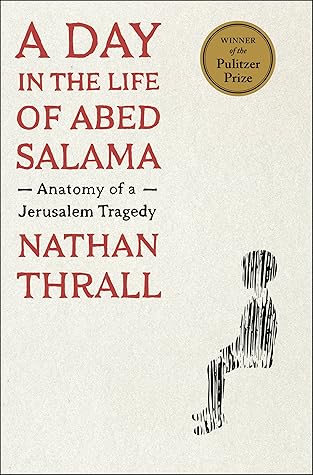More on this book
Community
Kindle Notes & Highlights
“We do not see our hand in what happens, so we call certain events melancholy accidents when they are the inevitabilities of our projects, and we call other events necessities merely because we will not change our minds.” —Stanley Cavell
More than 1,100 Palestinians were killed by Israeli soldiers or civilians during the six years of the uprising. Another 130,000 were wounded and some 120,000 were jailed. In those years, Israel had the largest per capita prison population in the world.
The Israeli military shut down all the Palestinian universities, making it impossible for Abed to get a degree.
Possession of the bayanaat, or of any PLO “propaganda material,” was a criminal offense, as was printing or publicizing “any publication of notice, poster, photo, pamphlet or other document containing material having a political significance.”
Three years later, in 1988, the PLO offered Israel a historic compromise, consenting to a Palestinian state in the occupied territories, just 22 percent of the homeland. The proposed state excluded Haifa, Jaffa, and the other towns its leaders had been exiled from, the places to which they had spent decades fighting to return.
Speaking to the US ambassador in Tel Aviv, who summarized the conversation in a diplomatic cable, Israel’s deputy defense minister referred to them as “apartheid roads.” If the theme of Oslo was segregation, its symbols were the barriers that Dany built: checkpoints, roadblocks, bypass roads, and, above all, fences and walls.
In February 1994, a Brooklyn-born religious settler, Baruch Goldstein, murdered twenty-nine Palestinian worshippers in Hebron. Significantly, he chose to do it on Purim, the holiday commemorating the biblical story of the Jews of Persia foiling a plot to destroy them and then killing “all their enemies with the stroke of the sword, and with slaughter, and destruction.” That year, Purim fell on the third Friday of Ramadan. Goldstein, a resident of Kiryat Arba near Hebron and a captain in the IDF reserves, put on his army uniform, took his assault rifle, and entered the Ibrahimi Mosque during
...more
The settlers made up less than half of one percent of Hebron’s population, but their presence curtailed the freedom of every Palestinian there.
What was once Palestinian territory dotted with Israeli settlements had been transformed by Dany’s vision into its photo negative: an Israeli West Bank enveloping dozens of small enclaves of limited Palestinian self-rule. “You’ve turned our autonomy into a prison for us,” the lead Palestinian negotiator, Abu Ala, said.
The Zionist left—and the United States—wanted something that looked less like a series of cages around Palestinian towns and more like a border fence that wrapped around the major settlement blocs but otherwise adhered fairly closely to the Green Line.
Parents who could afford it put their children in private schools, which were largely unregulated. In February 2012, one such school, Nour al-Houda, hired a bus company to take its kindergarten class to a play area in Kufr Aqab. The company sent an illegally registered twenty-seven-year-old bus to drive on neglected, congested roads, without proper lighting, a police presence, or a barrier between the lanes of oncoming traffic.
For all the blame that was cast, no one—not the investigators, not the lawyers, not the judges—named the true origins of the calamity. No one mentioned the chronic lack of classrooms in East Jerusalem, a shortage that led parents to send their children to poorly supervised West Bank schools. No one pointed to the separation wall and the permit system that forced a kindergarten class to take a long, dangerous detour to the edge of Ramallah rather than driving to the playgrounds of Pisgat Ze’ev, a stone’s throw away. There was no suggestion that Israel’s fund for accident victims should
...more
in the greater Jerusalem–Ramallah area, or objected that the checkpoints were used to stem Palestinian movement and ease settler traffic at rush hour. No one noted that the absence of emergency services on one side of the separation wall was bound to lead to tragedy. No one said that the Palestinians in the area were neglected because the Jewish state aimed to reduce their presence in greater Jerusalem, the place most coveted by Israel. For these acts, no one was held to account.


